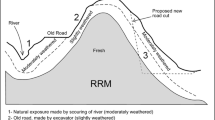Abstract.
The newly developed system presented in this paper is based on a three-step approach and on the probabilistic assessment of independently different failure mechanisms in a slope. First, the scheme classifies rock mass parameters in one or more exposures and allowance is made for weathering and excavation disturbance. This gives values for the parameters of importance to the mechanical behaviour of a slope in an imaginary, unweathered and undisturbed 'reference' rock mass. The third step is the assessment of the stability of the existing slope or any new slope in the reference rock mass, taking into account both method of excavation and future weathering. From the large quantity of data obtained in the field, the Slope Stability Probability Classification (SSPC) system has been proposed, based on the probabilities of different failure mechanisms occurring. Developed during 4 years of research in Falset, Tarragona province, Spain, it has been used with good results in Austria, South Africa, New Zealand and the Dutch Antilles.
Résumé.
Le nouveau système de classification présenté dans ce papier est basé sur une approche en trois étapes et sur une évaluation probabiliste de différents mécanismes de rupture de pentes.
D'abord, les paramètres du massif rocheux sont mesurés sur un ou plusieurs affleurements, tout en considérant les effets de l'altération et des perturbations du massif résultant de l'excavation. Cette démarche permet ensuite d'obtenir les valeurs des paramètres jouant un rôle important dans le comportement mécanique d'une pente pour un massif rocheux non altéré et non perturbé par le processus d'excavation. La troisième étape est l'évaluation de la stabilité des pentes dans le massif rocheux de référence, prenant en compte à la fois la méthode d'excavation et l'altération future. A partir du nombre important de données obtenues sur le terrain, le système de classification probabiliste de stabilité des pentes (SSPC) a été proposé, basé sur les probabilités d'occurrence de différents types de mécanismes de rupture. Développé pendant quatre ans à Falset, dans la province de Tarragone (Espagne), il a été utilisé avec de bons résultats en Autriche, Afrique du Sud, Nouvelle Zélande et aux Antilles néerlandaises.
Similar content being viewed by others
Author information
Authors and Affiliations
Additional information
Electronic Publication
Rights and permissions
About this article
Cite this article
Hack, .R., Price, .D. & Rengers, .N. A new approach to rock slope stability – a probability classification (SSPC). Bull Eng Geol Environ 62, 167–184 (2003). https://doi.org/10.1007/s10064-002-0155-4
Received:
Accepted:
Issue Date:
DOI: https://doi.org/10.1007/s10064-002-0155-4




